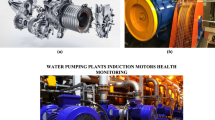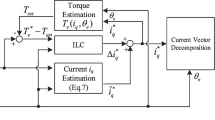Abstract
To compensate for the nonlinearity and to achieve finely-tuned tracking accuracy of a gun control system driven by an AC machine, an improved active disturbance rejection control (IADRC) strategy with neural network embedding (NN-IADRC) is developed in this paper. The proposed IADRC, which has amnestic memory effects, can be regarded as an extension of the conventional ADRC (CADRC), making it a special case of the IADRC. To further attenuate the dependence on system models and enhance the disturbance rejection capacities of the IADRC strategy, an on-line NN-based optimum updating approach is also developed in this paper. Finally, a series of experiments are conducted on the semi-physical simulation platform to estimate the performance of the control system and the effects of the memory factor on the system. The experimental results confirm that the proposed NN-IADRC is highly robust. The results also confirm that it performs more excellently than the CADRC and that its fine tuning has attained tracking accuracy.
Similar content being viewed by others
References
H. Xian, W. Yang and W. D. Zhang et al., The application of dual-PID regulation based on sliding mode control in a tank artillery stabilizer, In: 2011 Fourth International Conference on Intelligent Computation Technology and Automation, IEEE computer society, 2011, DOI: 10.1109/ICICTA.2011.190.
D. Yuan et al., Overview of adaptive compensation control of nonlinearities in tank gun control system, Fire control & command control, 35(11) (2010) 1–5.
L. Feng, X. J. Ma and Z. F. Yan et al., Method of adaptive fuzzy sliding mode control of gun control system of tank, Electric Machines and Control, 11(1) (2007) 65–69.
H. Liang, C. M. Ma and J. F. Pan et al. Current situation and development trend of autoloader in large caliber howitzer, Journal of Gun Launch and Control, 3 (2010) 103–107.
K. K. Ahn and T. D. C. Thanh, Nonlinear PID control to improve the control performance of the pneumatic artificial muscle manipulator using neural network, Journal of Mechanical Science and Technology, 19(1) (2005) 106–115.
D. Yuan, X. J. Ma, L. Y. Li et al., Adaptive compensation control method of nonlinearity in tank gun control system based on equivalent disturbance, Fire Control & Command Control, 36(6) (2011) 70–73.
L. Feng, X. M. Lei and X. J. Ma et al., Adaptive sliding mode robust control of gun control system of tank, Fire Control & Command Control, 35(10) (2010) 55–58.
J. Q. Han, From PID to active disturbance rejection control, IEEE Transactions on Industrial Electronics, 56(3) (2009) 900–906.
G. Tian and Z. Q. Gao, Benchmark tests of active disturbance rejection control on an industrial motion control platform, In: 2009 American Control Conference, St. Louis, MO, USA, 2009.
J. Vincent, D. Morris and N. Usher et al., On active disturbance rejection based control design for superconducting RF cavities, Nuclear Instruments and Methods in Physics Research A, 643 (2011) 11–16.
Y. Q. Xia, B. Liu and M. Y. Fu, Active disturbance rejection control for power plant with a single loop, Asian Journal of Control, 14(2) (2010) 1–12.
D. Wu and K. Chen, Application of active disturbance rejection control to variable spindle turning process, IEEE Transactions on Industrial Electronics, 56(7) (2009) 2746–2753.
S. L. Li, X. Yang and D. Yang, Active disturbance rejection control for high pointing accuracy and rotation speed, Automatica, 45(8) (2009) 1854–1860.
J. W. Jeong, P. H. Chang and K. B. Park, Sensorless and modeless estimation of external force using time delay estimation: application to impedance control, Journal of Mechanical Science and Technology, 25(8) (2011) 2051–2059.
D. K. Han and P. Chang, Robust tracking of robot manipulator with nonlinear friction using time delay control with gradient estimator, Journal of Mechanical Science and Technology, 24(8) (2010) 1743–1752.
W. Y. Chen, F. L. Chu and S. Z. Yan, Stepwise optimal design of active disturbances rejection vibration controller for intelligent truss structure based on adaptive genetic algorithm, Journal of Mechanical Engineering, 46(7) (2010) 74–81.
Z. X. Zhou, Y. Y. Qu and J. D. Yang et al., Speed regulation system of permanent magnet linear synchronous motor for machine tool feeding Based on improved ADRC. China Mechanical Engineering, 19(21) (2008) 2561–2565.
Z. X. Zhou, J. D. Yang, Y. Y. Qu et al., Horizontal thrust control of magnetic suspension platform Based on active disturbance rejection controller. Journal of Mechanical Engineering, 44(9) (2008) 193–199.
A. A. Stanislavsky, Memory effects and macroscopic manifestation of randomness. Physical Review E, 61(5) (2000) 4752–4759.
E. Ahmeda and A. S. Elgazzar, On fractional order differential equations model for nonlocal epidemics, Physica A, 379 (2007) 607–614.
M. S. Tavazoei and M. Haeri, Chaos control via a simple fractional-order controller, Physics Letters A, 372 (2008) 798–807.
C. B. Ma and Y. Hori, The application of fractional order control to backlash vibration suppression. In: Proceeding of the 2004 American Control Conference, Boston, Massachusetts, USA, 2004.
X. Q. Zhou, Z. W. Zhu and S. X. Zhao et al., An improved adaptive feedforward cancellation for trajectory tracking of fast tool servo based on fractional calculus. Procedia Engineering, 15 (2011) 315–320.
X. Q. Zhou, Z. W. Zhu and S. X. Zhao et al., A novel hybrid control strategy for trajectory tracking of fast tool servo, In: 2010 2nd International Conference on Mechanical and Electronics Engineering, Tokyo, Japan, 2010.
H. Leeghim, I. H. Seo and H. C. Bang, Adaptive nonlinear control using input normalized neural networks, Journal of Mechanical Science and Technology, 22(6) (2008) 1073–1083.
J. H. Chen and T. C. Huang, Applying neural networks to on-line updated PID controllers for nonlinear process control, Journal of Process Control, 14 (2004) 211–230.
Author information
Authors and Affiliations
Corresponding author
Additional information
Recommended by Associate Editor Kyongsu Yi
Qiang Gao obtained his B.S. and Ph.D. degrees in Nanjing University of Science and Technology in China in 2003 and 2008, respectively. He is currently a fulltime lecturer at the School of Mechanical Engineering at Nanjing University of Science and Technology, China. Dr. Gao’s research interests include intelligent modeling and control of AC/DC and electro-hydraulic servo systems.
Rights and permissions
About this article
Cite this article
Gao, Q., Sun, Z., Yang, G. et al. A novel active disturbance rejection-based control strategy for a gun control system. J Mech Sci Technol 26, 4141–4148 (2012). https://doi.org/10.1007/s12206-012-0879-4
Received:
Revised:
Accepted:
Published:
Issue Date:
DOI: https://doi.org/10.1007/s12206-012-0879-4




